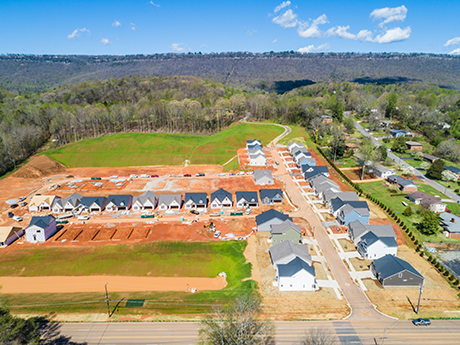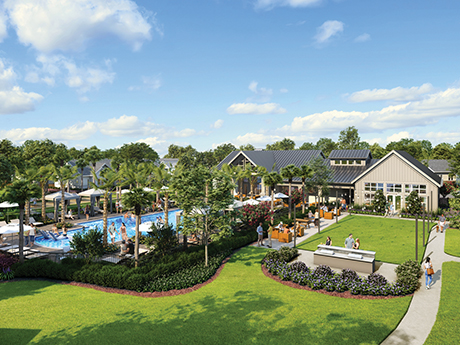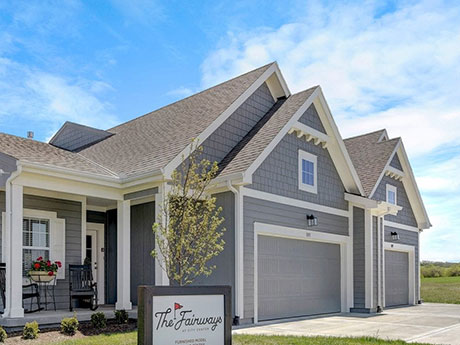LITCHFIELD PARK AND GOODYEAR, ARIZ. — Chicago-based Blue Vista Capital Management has purchased land for two build-to-rent developments in Litchfield Park and Goodyear. The transaction, representing approximately $102 million in total capitalized value, is part of Blue Vista’s ongoing strategy of providing institutional investors with access to unique and differentiated core plus residential real estate opportunities. Located near the intersection of Dysart and Camelback roads, the Litchfield Park community will offer 153 residences with 54 one-bedroom duplex units and 99 detached two-bedroom, single-family units totaling 137,043 square feet. Situated near the intersection of Sarival Avenue and Yuma Road, the Goodyear community will feature 151 units in a mix of 60 one-bedroom duplexes and 91 detached two-bedroom, single-family units totaling 132,985 square feet. Upon completion, the projects will offer more than 300 homes with secure private gated entrances, private outdoor space, simulated wooden flooring, quartz countertops, stainless steel appliances, in-unit washers/dryers and nine- to 10-foot ceilings. Community amenities will include resort-style pools, clubhouses and outdoor lounge areas with grills.
Single-Family Rental
Haven Realty Capital, Yieldstreet Acquire Build-to-Rent Community in Chattanooga for $28.6M
by John Nelson
CHATTANOOGA, TENN. — Los Angeles-based Haven Realty Capital, in a joint venture with funds managed by New York City-based Yieldstreet, has closed on the first phase of a $28.6 million acquisition of Hartman Hill, a 71-home build-to-rent (BTR) residential community in Chattanooga. The Haven-led joint venture will close on the remaining homes in phases over the next seven months. Hartman Hill is being developed on a 26-acre site at 5005 Dayton Blvd. in the Red Bank neighborhood, approximately eight miles north of downtown Chattanooga. At full buildout, the property will offer three- and four-bedroom homes ranging in size from 1,538 to 2,515 square feet. Each of the two-story homes will offer custom cabinetry with soft-close drawers, quartz countertops, tile backsplashes, stainless steel appliances, private backyards and direct access garages. Common area amenities will include a sports court, bark park and a pet washing station. The new ownership will maintain the landscaping for all homes and common areas.
Affordable HousingBohlerBuild-to-RentContent PartnerDevelopmentFeaturesMidwestMultifamilyNortheastSingle-Family RentalSoutheastTexasWestern
Build-to-Rent Planning and Entitlements: How to Avoid Challenges
The build-to-rent (BTR) property type has gained significant traction in the commercial real estate market due to increasing interest from tenants, investors and developers. Developers moving into the BTR market before 2020 originally focused on this sector as an “in between” product for future home buyers who weren’t ready to commit to a single location but wanted additional space and amenities. The pandemic fueled tenants’ desires for more privacy and space without the long-term commitment of homeownership, which ignited growth in the sector. As costs for single-family homes continue to rise, the BTR niche also increasingly attracts would-be homeowners who are priced out of the homebuying market — and the growing demand for BTR properties draws the attention of more and more investors and developers. But not all stakeholders are immediately on board with development of BTR properties. The concept is rather new in some markets and local communities have questions about the zoning and operation of these hybrid communities, which are an intriguing mix of single-family concept and multifamily operations. Developers often need to educate municipalities about the BTR concept — and they need to plan BTR properties that work for the local community. This is where Bohler — a land …
CONROE, TEXAS — Chicago-based financial advisory firm Tempo Capital Group has arranged a $42 million nonrecourse construction loan for a 287-unit single-family rental project in Conroe, about 35 miles north of Houston. The project will be situated on a 45-acre site and will feature cottages, duplexes and two-story homes. Amenities will include a pool, fitness center and clubhouse. The direct lender and borrower were not disclosed. A construction timeline was also not released. Michael Berke led the debt placement for Tempo Capital Group.
Build-to-RentConference CoverageDevelopmentFeaturesMultifamilyNorth CarolinaSingle-Family RentalSouth CarolinaSoutheastSoutheast Feature Archive
Speed to Market is ‘Almost the Only Priority’ for Multifamily Developers Looking to Avoid Cost Risks, Say InterFace Panelists
by John Nelson
CHARLOTTE, N.C. — Multifamily developers are pushing their chips in and aggressively looking for new development deals, especially for sites in and around high-growth markets in the Southeast. Michael Tubridy, senior managing director of Crescent Communities, said his firm isn’t leaving anything to chance and is looking to move quickly on development opportunities. “We’re trying to get as many units on the ground today as possible, because tomorrow will be more expensive,” said Tubridy. “I like the chances of today’s cost environment a lot better than I like the unknown of where we’ll be a year from now or two years from now. Putting a premium on speed to market is something that we are much more focused on; it’s almost the only priority right now.” Tubridy’s comments came during the development panel at InterFace Carolinas Multifamily 2022. The half-day event was held on April 14 at the Hilton Uptown Charlotte hotel and attracted more than 260 attendees from all facets of the multifamily industry in North Carolina and South Carolina. Michael Saclarides, director of Cushman & Wakefield’s Multifamily Advisory Group, moderated the discussion. Crescent Communities is far from the only multifamily developer pursuing ground-up construction opportunities in earnest. In …
MCKINNEY, TEXAS — Metro Philadelphia-based investment firm Morgan Properties has purchased parcHaus at Skyline, a 136-unit single-family rental community located on the northern outskirts of Dallas in McKinney. The newly built community features one-, two- and three-bedroom homes with garages and private backyards. The amenity package comprises a pickleball court, pool, dog park and a business center. Dallas-based Provident Realty Advisors sold the property for an undisclosed price. Morgan Properties has rebranded the community as Elevate at Skyline.
If there were any doubt that student housing stakeholders were quickly moving into the single-family build-to-rent market, the question was just settled for good. Chicago-based Harrison Street, one of the industry’s biggest players, recently announced a blockbuster deal to form a joint-venture with Core Spaces, one of student housing’s biggest developers. But this venture isn’t about student housing; it will invest up to $1.5 billion in subdivisions with hundreds of rental homes in markets such as Austin, Denver, Dallas, Orlando and Nashville. “We had an ah-ha moment,” says Justin Gronlie, managing director and Head of Education Real Estate at Harrison Street. He explains that Harrison Street was among the first firms to invest cottage-style student housing back in 2007, and since then, has developed and acquired more than 27 BTR-style student housing communities comprising 19,000 beds. The off-campus single-family style homes in highly amenitized developments are similar to the product in build-to-rent communities. “Due to our unique experience and track record in student housing, we recognized the patterns and magnitude of the BTR opportunity in front of us and pounced at it,” says Gronlie. Like student cottage projects, build-to-rent (BTR) or build-for-rent (BFR) developments offer detached units, townhomes or …
RICHMOND, TEXAS — Houston-based REIT Camden Property Trust has acquired 16 acres in the southwestern Houston suburb of Richmond for the development of a single-family rental community that will total 180 to 200 residences. The site is located within the 58-acre Grand Center at Long Meadow Farm mixed-use development. Ashley Strickland of NewQuest Properties represented the seller, CJ Development, in the sale of the land. Kenneth Danna of Dosch Marshall Real Estate represented Camden Property Trust. A construction timeline was not disclosed.
CELINA, TEXAS — Mill Creek Residential is underway on construction of Amavi Celina, a 271-unit build-to-rent residential community that will be located about 35 miles north of Dallas. The unit mix will consist of 155 cottages, 94 townhomes and 22 single-family detached homes. Amavi Celina will span 45 acres and will feature a trail system, dog park, fitness center and resort-style pool. Keaton Merrell and Shannon Hersker of Walker & Dunlop originated a four-year, interest-only construction loan to Mill Creek Residential for the project, a completion date for which was not disclosed.
LENEXA, KAN. — Hunt Midwest and Park Place Partners have sold The Fairways Villas at City Center in Lenexa, a southern suburb of Kansas City, for $42.5 million. Colorado-based Griffis/Blessing Inc. purchased the build-to-rent community, which features 80 homes and is situated next to Canyon Farms Golf Course. Hunt Midwest and Park Place Partners completed development of the property in early 2020. The homes average 2,289 square feet across two levels and include a two-car garage. Monthly rents start around $3,605.






